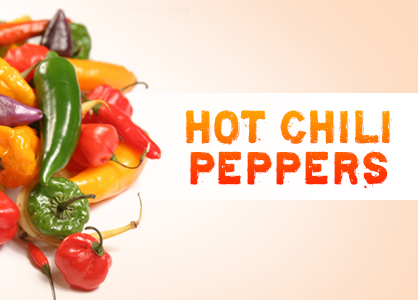5 Top Chili Peppers
For those that think a chili pepper is a chili pepper, read on. Here we dish you all the info on some of the more common chili peppers, from the smoky chipotle to the super-hot fruity habanero, in appetizing recipes such as Angry Shrimp with Tuscan White Beans, Apricot Salsa, Jamaican Fried Snapper or Spicy Paella with Chile, Lime, and Cilantro. Learn there is more to each pepper than simply its level of spice. Different varieties possess varying flavors and are commonly used for different cooking purposes.
Poblano
If you are not a fan of intense heat, a poblano pepper may be the way to go, especially if you remove the veins and seeds. A mild, heart-shaped pepper, this chili’s thick walls make it ideal for stuffing. The dark green poblano is the base of the well-known chile relleno, in which the pepper is stuffed with cheese, coated in egg and fried. Large and with a tough skin, poblanos are often charred or peeled first; roast them to bring out the full flavor. The mellow chili gets its name from its origins, the state of Puebla in central Mexico. When dried, it is referred to as the ancho chili. Poblanos weigh in between 1,000 and 2,000 Scoville heat units on the Scoville Scale, used to measure the hotness of chili peppers. Try a healthy stuffed version of the poblano pepper with the Black Bean-Stuffed Poblano Peppers, which fills the peppers with a vegetable medley of mushrooms, zucchini and corn atop a bed of lime cilantro quinoa. Poblanos also lend well to chilies, such as the Marvelous Meatless Chili with a three bean mix spiced up with cumin and cocoa.
Chipotle
The smoked, dried, ripe jalapeño, chipotles are known for their smoky flavor and medium heat. Indigenous to Mexico and dating back to the time of the Aztecs, chipotle peppers are a popular and versatile chili. Commonly found whole and dried, as hot sauce, or canned in adobe sauce, this dried dark brown chili gives flavor to simmered recipes such as beans and stews, heat to cornbread or pasta and smokiness to spice rubs and salad dressings. The peppers stay on the plant until they become deep red and start to dry out. The resulting deep red jalapeños are then smoked for days till entirely dry. Although dried, the pepper still retains a great deal of the jalapeño’s heat, weighing in at about 5,000 to 10,000 Scoville heat units. The pepper has a great deal of flavor, so a little bit goes a long way. While you can smoke your own, chipotle is easily found at most supermarkets, sometimes in the Mexican foods section. It can add zing to roasted potatoes or even homemade popcorn. Put it in a hot sauce such as this Chipotle Sauce or use it to spice up side dishes such as Chipotle Mashed Sweet Potatoes. Its smoky flavor is perfect in Chipotle Chicken and Rice, a great main dish.
Serrano
Appearing like a slender jalapeño between 1 and 2 inches in length, this rich dark green or red hot pepper gives plenty of heat. Its thin walls mean it does not need to be steamed or peeled before using, making this hot chili perfect for salsas, as well as well suited to marinades and chilies. Because it is difficult to core and seed, if you want less heat, use less of the pepper. As a meaty variety, it is best fresh as it does not perform well dried. Scoring between 8,000 and 22,000 Scoville heat units, it is about five times hotter than its jalapeño cousin. Serrano peppers are readily available fresh in the produce section of an average supermarket. Their heat lends itself well to Angry Shrimp with Tuscan White Beans, which doctors up shrimp with basil, orange peel, bread crumbs and the chili. A good complement to chicken, mix up the Roasted Pineapple with Serrano Chili, the perfect combo of sweet and spicy uniquely complemented with mustard, saffron and lime juice.
Habanero
This bright yellow or orange pepper is the hottest readily available chili in the United States, easily found at local grocery stores. You may also find it in white, brown or pink varieties. Tangy and rounded, their small size does not betray their heat: Habaneros usually score 200,000 to 300,000 Scoville heat units. This chili is so hot you have to wear gloves when handling it and wash down anything the seeds or juice touch – its oil can be painful. With a fruity, citrus-like pungent flavor and intensity, the habanero is often the base of many hot sauces and salsas. The pepper takes its name from the Cuban city, meaning “from Habana.” This very hot lantern-shaped chili is best in the summertime. Try its spiciness in the Jamaican Fried Snapper with a sweet and sour sauce, get fruity with a colorful summer Apricot Salsa or use it to create your very own hot sauce, such as Spicy Habanero Hot Sauce made with roasted peppers.
Anaheim
Another milder choice, Anaheim chilies are a long green pepper easily diced or pureed to give flavor to sauces and soups. Get rid of the tough skin by charring and steaming. Named for the California city that popularized them in the early 1900s, Anaheim chilies have a sweet taste reminiscent of bell peppers with a hint of heat. Great roasted, these large cone-shaped peppers are commonly stuffed, added to stir-fries for a kick, or diced in mild salsas. Still commonly found in supermarkets today, Anaheim chilies rate between 1,000 and 2,000 Scoville heat units. Try it in this Spicy Paella with Chile, Lime, and Cilantro, whose name says it all, or in Yucatán Shrimp Cocktail Salad, a Mexican salad featuring the simple flavors of avocado, tomatoes, cucumber and shrimp with a hint of honey and lime.

LadyLUX



